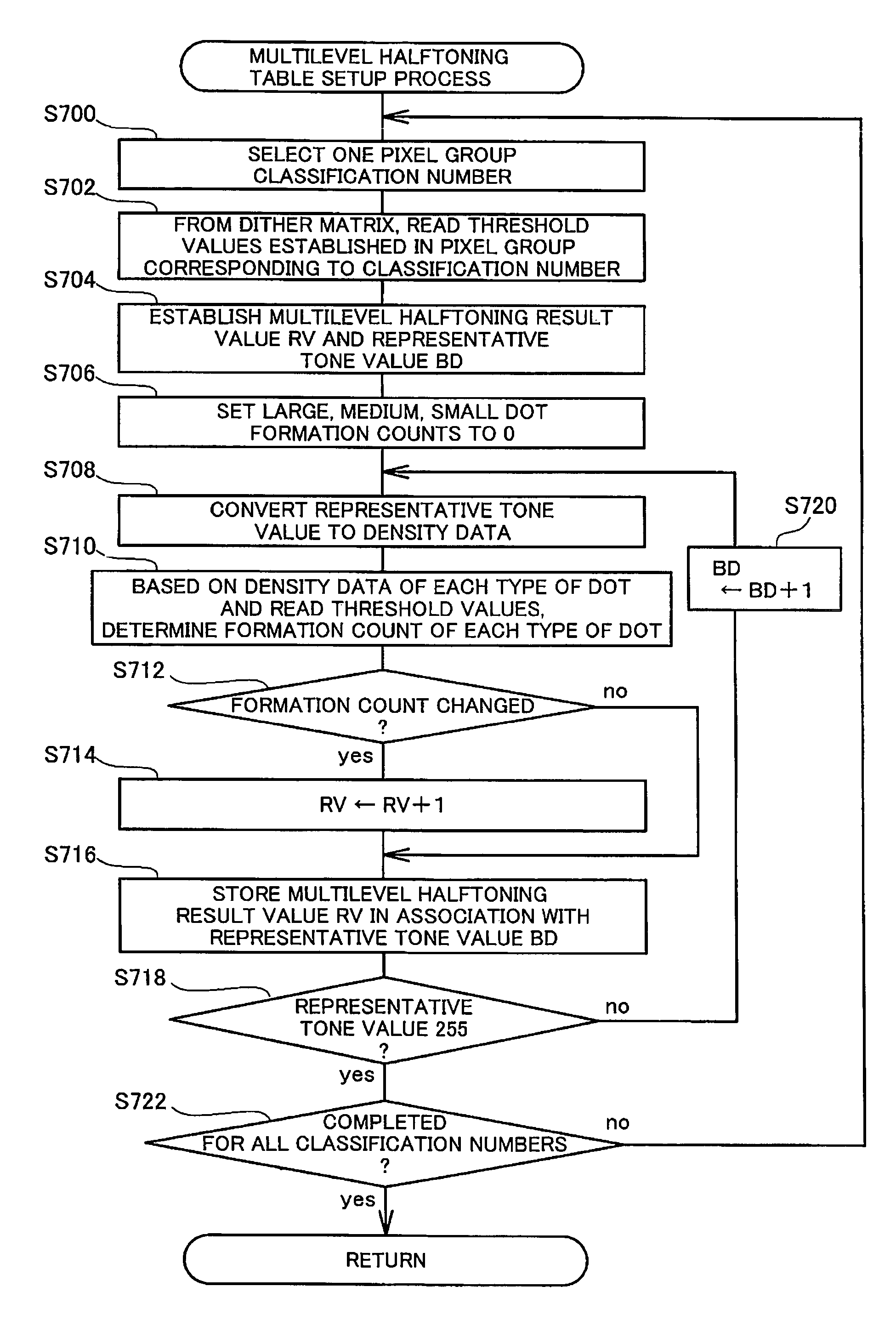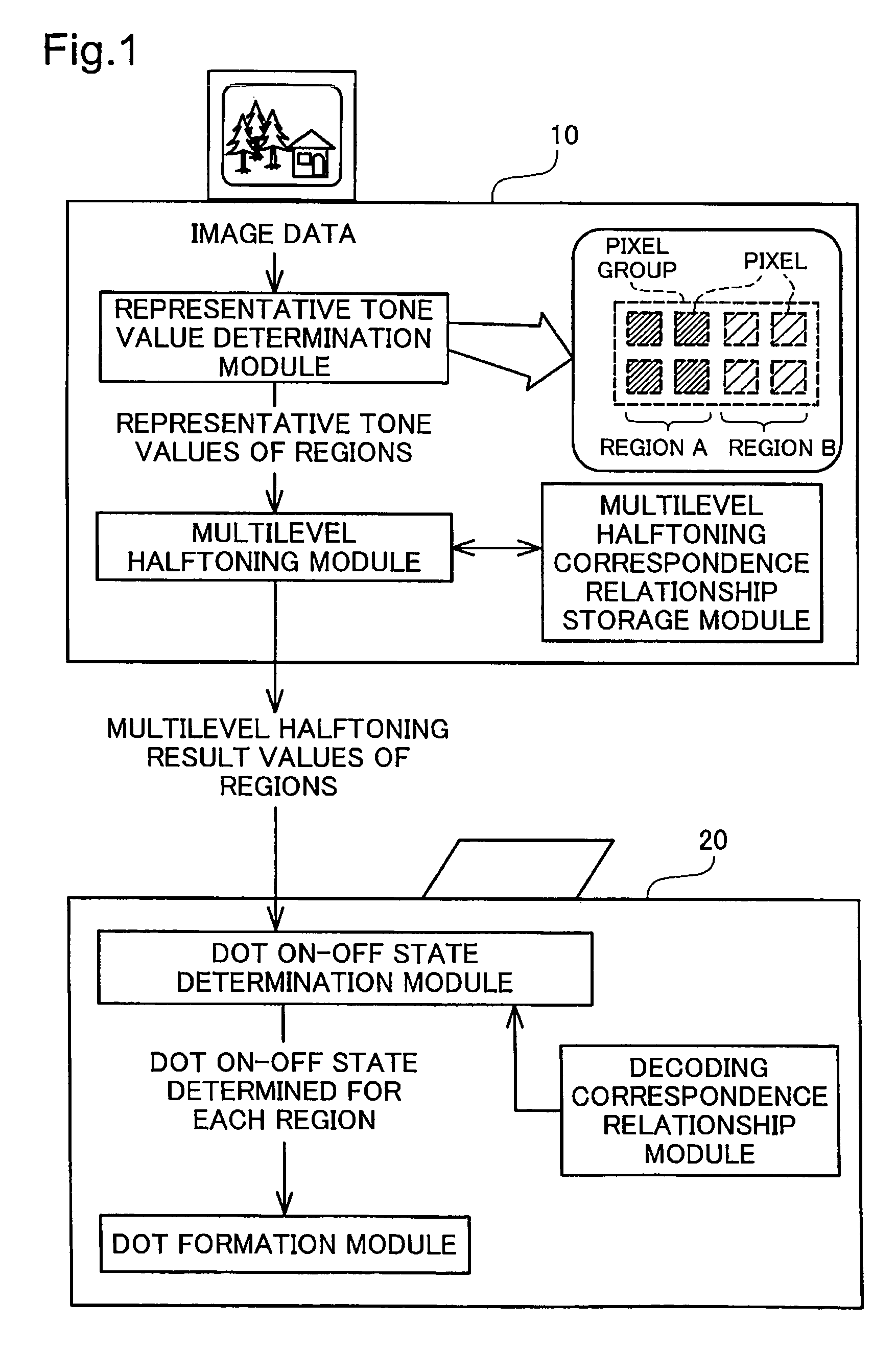Image processing system, image processing device, dot data processing device, and method and program product therefor
a technology of image data and image processing system, applied in the field of image processing system, can solve the problems of limiting the effectiveness of the aforementioned technology in speeding up the output of images, requiring more time for image processing, so as to achieve rapid output of images and high picture quality
- Summary
- Abstract
- Description
- Claims
- Application Information
AI Technical Summary
Benefits of technology
Problems solved by technology
Method used
Image
Examples
first embodiment
C. Overview of Image Printing Process of
[0142]C-1. Basic Principle by which Pixel Location is Determinable from Count Data:
[0143]C-2. Multilevel Halftoning Result Value Creation Process of First Embodiment
[0144]C-3. Classification Number Determination Process:
[0145]C-4. Multilevel Halftoning Table
[0146]C-5 Data Format of Multilevel Halftoning Result Values
[0147]C-6. Dot On-off State Determination Process of First Embodiment:
[0148]C-7. Alternative Embodiments of First Embodiment:
D. Second Embodiment
[0149]D-1. Overview of Image Printing Process of Second Embodiment:
[0150]D-2. Multilevel Halftoning Result Value Creation Process of Second Embodiment:[0151]D-2-1. Large / Medium / Small Dot Count Determination Process Using Dither Method[0152]D-2-2. Specifics of Multilevel Halftoning Result Value Creation Process of Second Embodiment:
[0153]D-3. Dot On-off State Determination Process of Second Embodiment:
E. Third Embodiment:
[0154]E-1. Multilevel Halftoning Result Value Creation Process of Thir...
second embodiment
D. Second Embodiment
[0322]In The first embodiment discussed previously, there was described a case in which the color printer 200 is capable of producing only a single type of dot. However, for the purpose of increasing the image quality, printers capable of producing several types of dot (so called halftone dot printers), such as dots with variable size or dots with variable ink density, enjoy widespread use nowadays. The invention can be highly effective when implemented in such a halftone dot printer. Implementation of the invention in a half-tone dot printer will be explained below, by way of a second embodiment.
[0323]D-1. Overview of Image Printing Process of Second Embodiment:
[0324]In terms of the flowchart, the image printing process according to the second embodiment is the analogous to the image printing process according to The first embodiment shown in FIG. 5. An overview of the image printing process according to second embodiment will be explained briefly below, again r...
third embodiment
E. Third Embodiment
[0387]In the first embodiment or the second embodiment discussed previously, the meaning of a multilevel halftoning result value can be interpreted in the same way regardless of the pixel group for which the result value is derived. For example, in The first embodiment, a multilevel halftoning result value of 3 represents formation of three dots within the pixel group, regardless of which pixel group the result value was derived for. In the second embodiment, a multilevel halftoning result value of 125 represents that large dots, medium dots, and small dots will be formed in certain numbers respectively within the pixel group, depending on the correspondence relationship depicted in FIG. 36. Where multilevel halftoning result values derived for different pixel groups have the same value in this way, their meaning can be interpreted in the same way. However, the specific meaning of multilevel halftoning result values can also be made to differ depending on the pixe...
PUM
 Login to View More
Login to View More Abstract
Description
Claims
Application Information
 Login to View More
Login to View More - R&D
- Intellectual Property
- Life Sciences
- Materials
- Tech Scout
- Unparalleled Data Quality
- Higher Quality Content
- 60% Fewer Hallucinations
Browse by: Latest US Patents, China's latest patents, Technical Efficacy Thesaurus, Application Domain, Technology Topic, Popular Technical Reports.
© 2025 PatSnap. All rights reserved.Legal|Privacy policy|Modern Slavery Act Transparency Statement|Sitemap|About US| Contact US: help@patsnap.com



